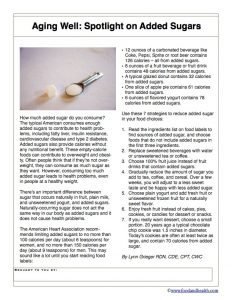Aging Well: Spotlight on Added Sugars
How much added sugar do you consume? The typical American consumes enough added sugars to contribute to health problems, including fatty liver, insulin resistance, cardiovascular disease and type 2 diabetes. Added sugars also provide calories without any nutritional benefit. These empty-calorie foods can contribute to overweight and obesity. Often people think that if they’re not overweight, they can consume as much sugar as they want. However, consuming too much added sugar leads to health problems, even in people at a healthy weight.There’s an important difference between sugar that occurs naturally in fruit, plain milk, and unsweetened yogurt, and added sugars. Naturally-occurring sugar does not act the same way in our body as added sugars and it does not cause health problems.The American Heart Association recommends limiting added sugars to no more than 100 calories per day (about 6 teaspoons) for women, and no more than 150 calories per day (about 9 teaspoons) for men. The Dietary Guidelines for Americans and MyPlate recommend that no more than 10% of daily calories come from added sugars, which is roughly 200 calories per day. This may sound like a lot until you start reading food labels:
- 12 ounces of a carbonated beverage like Coke, Pepsi, Sprite or root beer contains 126 calories – all from added sugars.
- 8 ounces of a fruit beverage or fruit drink contains 48 calories from added sugars.
- A typical glazed donut contains 32 calories from added sugars.
- One slice of apple pie contains 61 calories from added sugars.
- 6 ounces of flavored yogurt contains 78 calories from added sugars.
Use these 7 strategies to reduce added sugar in your food choices:
- Read the ingredients list on food labels to find sources of added sugar, and choose foods that do not include added sugars in the first three ingredients.
- Replace sweetened beverages with water or unsweetened tea or coffee.
- Choose 100% fruit juice instead of fruit drinks that contain added sugars.
- Gradually reduce the amount of sugar you add to tea, coffee, and cereal. Over a few weeks, you will adjust to a less sweet taste and be happy with less added sugar.
- Choose plain yogurt and add fresh fruit or unsweetened frozen fruit for a naturally sweet flavor.
- Enjoy fresh fruit instead of cakes, pies, cookies, or candies for dessert or snacks.
- If you really want dessert, choose a small portion. 20 years ago a typical chocolate chip cookie was 1.5 inches in diameter. Today’s cookies are often at least twice as large, and contain 70 calories from added sugar.
Look for these sources of added sugars in foods:
- anhydrous dextrose
- brown sugar
- confectioner's powdered sugar
- corn syrup
- corn syrup solids
- dextrose
- fructose
- high-fructose corn syrup (HFCS)
- honey
- invert sugar
- lactose
- malt syrup
- maltose
- maple syrup
- molasses
- nectars (e.g., peach nectar, pear nectar)
- pancake syrup
- raw sugar
- sucrose
- sugar
- white granulated sugar
By Lynn Grieger RDN, CDE, CPT, CWCReferences:
- Dietary Guidelines 2015-2020. https://health.gov/dietaryguidelines/2015/guidelines/chapter-2/current-eating-patterns-in-the-united-states/ Accessed 2-7-17
- Stanhope KL. Sugar consumption, metabolic disease and obesity: The state of the controversy. Critical reviews in clinical laboratory sciences. 2016;53(1):52-67. doi:10.3109/10408363.2015.1084990.
- American Heart Association. Sugar 101. http://www.heart.org/HEARTORG/HealthyLiving/HealthyEating/Nutrition/Sugar-101_UCM_306024_Article.jsp#.WJ5iSvkrL4c Accessed 2-10-17

